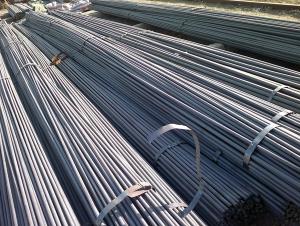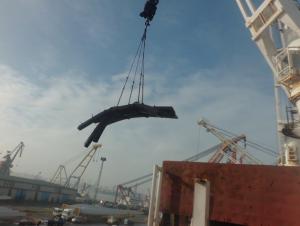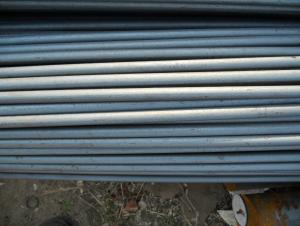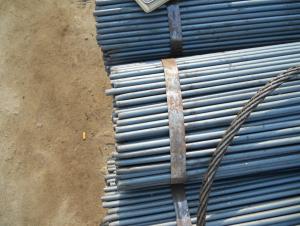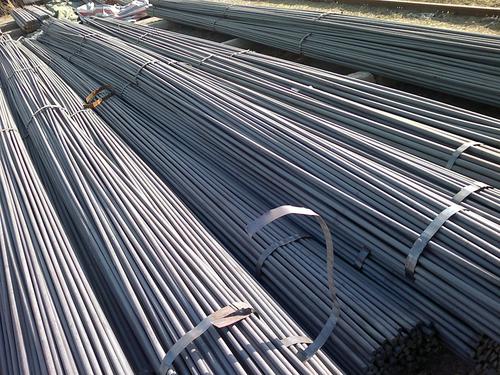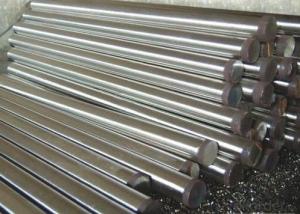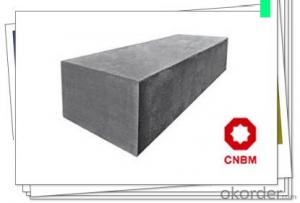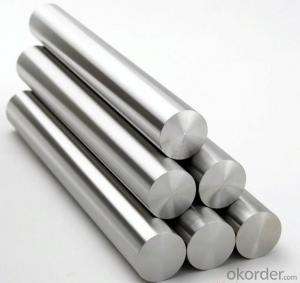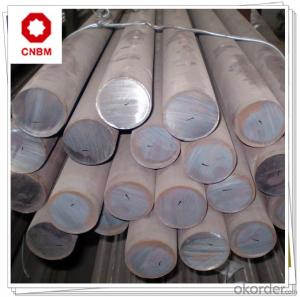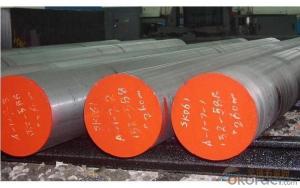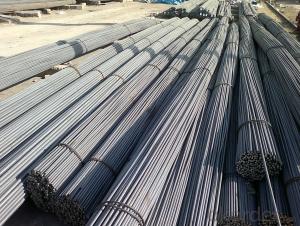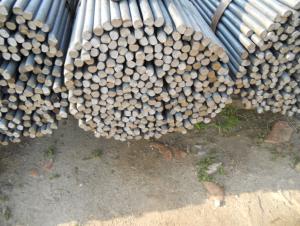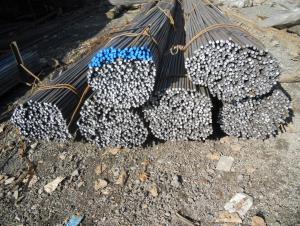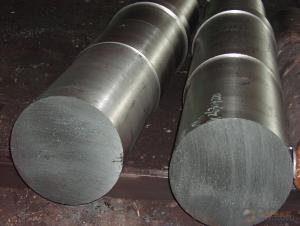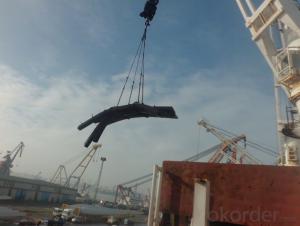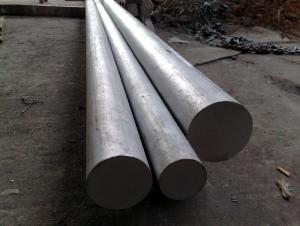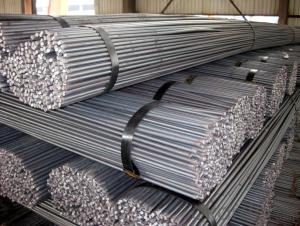steel round bar
- Loading Port:
- China Main Port
- Payment Terms:
- TT OR LC
- Min Order Qty:
- -
- Supply Capability:
- -
OKorder Service Pledge
OKorder Financial Service
You Might Also Like
Specifications of High Quality Round Bar
1. Grade: GB, JIS, ASTM, EN
2. Grade: Q235, SS400, A36, S235JR
3. Diameter and mass: As below
Diameter | Mass | Diameter | Mass | Diameter | Mass |
(mm) | (kg/m) | (mm) | (kg/m) | (mm) | (kg/m) |
6 | 0.22 | 22 | 2.98 | 53 | 17.30 |
7 | 0.30 | 24 | 3.55 | 56 | 19.30 |
8 | 0.40 | 25 | 3.85 | 60 | 22.20 |
9 | 0.50 | 26 | 4.17 | 63 | 24.50 |
10 | 0.62 | 28 | 4.83 | 65 | 26.00 |
11 | 0.75 | 30 | 5.55 | 70 | 30.20 |
12 | 0.89 | 32 | 6.31 | 75 | 34.70 |
13 | 1.04 | 34 | 7.13 | 80 | 39.50 |
14 | 1.21 | 36 | 7.99 | 85 | 44.50 |
15 | 1.39 | 38 | 8.90 | 90 | 49.90 |
16 | 1.58 | 40 | 9.86 | 95 | 55.60 |
17 | 1.78 | 42 | 10.90 | 100 | 61.70 |
18 | 2.00 | 45 | 12.50 | 120 | 88.85 |
19 | 2.23 | 48 | 14.20 | 140 | 120.93 |
20 | 2.47 | 50 | 15.40 | 150 | 138.82 |
4. Material: Mild Steel
5. Heat treatment of high quality steel:
Fire: Isothermal annealing temperature is 800 ~ 880 °C, with 10 ~ 20 °C, the furnace cooling to about 600 °C, hardness above HB269.
Preheat temperature: 730-730 °C
Quenching temperature: 1190-1210 °C
Tempering temperature: 540-595 °C
Cold drawn, hardness 285 HBS
Cold drawn after annealing condition, hardness 277 HBS
Quenching methods: oil quenching, air cooling or salt bath quenching
Usage and Applications of High Quality Round Bar
1) Suitable for making various strong cutting tool abrasion resistance, impact resistance.
2) Used to produce all kinds of high hard and super hard saw blade, drill, tap, broach, gear hob and various kinds of milling cutter.
3) Used for advanced punching die, screw die, and the toughness and complicated shape of the punch, etc.
4) Is used for cold forging die and drawing mode, etc.
5) Recommended watchcase factory, screw factory and other cold stamping products industry use.
Packaging & Delivery of High Quality Round Bar
Packaging Detail: All goods are packed in bundle with steel strips and shipped by break bulk vessel or container (depend on target market and different ports)
Delivery Detail: 45 days
Trade terms: FOB, CFR, CIF
MOQ: 25 tons per specification; we can negotiate the quantity if the specification is normal or we have stock of one specification.
Weight: The price invoicing on theoretical weight basis or actual weight basis depends on customer’s request.
Shipment: The shipment of bulk break or container is depends on customer’s request and the situation of the port of destination.
Documents given: Full set of original clean on board bill of lading; Original signed commercial invoice; Original packing list; Policy of insurance; Certificate of origin and what the target market needs.
Production Flow of High Quality Round Bar
The common processes are preheated forging quenching, dual refinement solution process, cooling quenching and isothermal quenching. We use heat treatment for dual refinement solution process. The main measures process is high temperature solution and refinement cycle. High temperature solution can improve the carbide morphology and particle size. The aim is to make the loop refinement ultrafine austenite grains.
- Q: What is the modulus of elasticity of a steel round bar?
- The modulus of elasticity of a steel round bar typically ranges from 190 to 210 gigapascals (GPa).
- Q: How do steel round bars perform under bending or flexing forces?
- Steel round bars exhibit excellent performance when subjected to bending or flexing forces due to their exceptional tensile strength and ductility. Their ability to resist deformation and retain their shape makes them highly suitable for various applications in construction, manufacturing, and engineering. Moreover, the combination of high strength and ductility enables these bars to evenly distribute and absorb applied loads, thereby minimizing the risk of failure or breakage. To further enhance the behavior of steel round bars under bending or flexing forces, several factors come into play, including alloy composition, heat treatment, and manufacturing processes. Different grades of steel offer varying levels of strength, toughness, and bending resistance. Additionally, heat treatment techniques such as quenching and tempering can significantly enhance the bars' mechanical properties, rendering them more resistant to bending and flexing. Nevertheless, it is crucial to acknowledge that excessive bending or flexing can result in permanent deformation or failure of steel round bars. Overloading or repeatedly subjecting the material to bending beyond its limits can lead to stress concentrations, microcracks, or even fractures. Consequently, it is of utmost importance to establish appropriate bending limits and ensure proper design and installation to uphold the structural integrity and safety of steel round bars when exposed to bending or flexing forces.
- Q: Can steel round bars be used for making exhaust systems?
- Indeed, exhaust systems can be fabricated using steel round bars. Steel, being renowned for its endurance, resistance to heat, and capacity to endure extreme temperatures and harsh surroundings, is widely favored as a material for exhaust systems. By utilizing steel round bars, one can fashion the pipes, mufflers, and other constituents of an exhaust system. Moreover, these bars can be readily welded and molded into the preferred shape, enabling customization and design flexibility. Furthermore, steel round bars can furnish the essential strength and structural soundness imperative for an effective and enduring exhaust system.
- Q: Can steel round bars be machined using CNC equipment?
- Indeed, CNC equipment is capable of machining steel round bars. By utilizing computer programs to govern the movement of cutting tools, CNC machines can execute a vast array of operations on diverse materials, including steel round bars. These operations encompass turning, milling, drilling, and threading, effectively achieving the desired shape, dimensions, and surface finish. Notably, CNC machines exhibit exceptional repeatability, consistency, and efficiency, rendering them an optimal selection for machining steel round bars in industries such as automotive, aerospace, construction, and manufacturing.
- Q: How are steel round bars manufactured?
- Steel round bars are typically manufactured through a process known as hot rolling, where a large steel billet is heated and passed through a series of rollers which gradually shape and size it into a round bar. This process ensures the bar's uniformity, strength, and durability, making it suitable for various applications in industries such as construction, manufacturing, and engineering.
- Q: Are steel round bars suitable for machining operations?
- Steel round bars are an ideal choice when it comes to machining. The high strength and durability of steel make it a top-notch material for numerous machining processes. It's easy to shape, cut, drill, and turn steel round bars to create precise components and parts. When it comes to achieving the desired shape, size, and finish, milling, drilling, and turning can efficiently be performed on steel round bars. The dimensional stability and mechanical properties of steel round bars are exceptional, resulting in accurate and consistent machining outcomes. Whether it's the automotive, aerospace, construction, or manufacturing industry, steel round bars are a dependable option for machining operations.
- Q: How do you store excess steel round bars?
- To store excess steel round bars, it is important to follow certain guidelines to ensure their longevity and prevent any damage. Here are a few steps you can take: 1. Properly clean and inspect the steel round bars before storage. Remove any dirt, grease, or moisture from the surface to prevent corrosion. 2. Choose an appropriate storage location. Ideally, it should be a dry, well-ventilated area with stable temperatures. Avoid storing the bars in areas prone to moisture, extreme heat, or direct sunlight. 3. Use racks or pallets to store the bars. Stack them horizontally, one on top of another, with enough space between each layer to prevent deformation or bending. 4. If storing the bars outdoors, cover them with a waterproof tarp or protective coating to shield them from rain, snow, and other elements. 5. Avoid placing excessive weight on top of the bars to prevent deformation. Be mindful of any sharp objects or edges nearby that could cause damage. 6. Regularly inspect the stored bars to ensure no signs of corrosion, rust, or other damage. If any issues are detected, take the necessary steps to address them promptly. Remember, proper storage is crucial to preserve the quality and integrity of the steel round bars. By following these guidelines, you can ensure that your excess steel round bars remain in good condition until they are needed for future use.
- Q: What are the advantages of using copper-alloy steel round bars?
- There are several advantages of using copper-alloy steel round bars in various applications. Firstly, copper-alloy steel round bars offer excellent corrosion resistance. The presence of copper in the alloy helps to protect the steel from rust and corrosion, making it suitable for use in environments with high levels of moisture or chemicals. This corrosion resistance extends the lifespan of the round bars, reducing the need for frequent replacements and maintenance. Secondly, copper-alloy steel round bars have high thermal and electrical conductivity. The copper content in the alloy enhances these properties, making them ideal for applications that require efficient heat transfer or electrical conductivity. This makes them suitable for use in electrical components, heat exchangers, and other similar applications. Another advantage of copper-alloy steel round bars is their superior machinability. Copper has excellent machinability properties, which allows for easy cutting, drilling, and shaping of the round bars. This makes them easier to work with and reduces machining time and costs. Additionally, copper-alloy steel round bars offer good strength and toughness. The steel component in the alloy provides the necessary strength to withstand heavy loads and impacts, while the copper component enhances the toughness, making them resistant to cracking or breaking under stress. This makes them suitable for use in structural applications, where high strength and durability are required. Furthermore, copper-alloy steel round bars exhibit good thermal stability. They can withstand high temperatures without losing their mechanical properties, making them suitable for applications that involve exposure to extreme heat or thermal cycling. In conclusion, the advantages of using copper-alloy steel round bars include excellent corrosion resistance, high thermal and electrical conductivity, superior machinability, good strength and toughness, and high thermal stability. These properties make them a preferred choice in various industries, including construction, electrical, automotive, and manufacturing.
- Q: Do steel round bars have a maximum load capacity?
- Yes, steel round bars have a maximum load capacity. The load capacity depends on various factors such as the diameter, length, and grade of the steel used. Engineering calculations and standards determine the maximum load capacity for specific applications and ensure the safety of the structure or component being supported by the steel round bars.
- Q: What are the different types of steel round bar alloys used in the automotive industry?
- In the automotive industry, there are several types of steel round bar alloys used due to their various properties and applications. 1. Carbon Steel: Carbon steel round bars are widely used as they offer good strength and toughness. They are used in various automotive components such as axles, crankshafts, and gears. 2. Alloy Steel: Alloy steel round bars contain additional alloying elements such as chromium, nickel, or molybdenum. These alloys enhance the mechanical properties of the steel, making it stronger and more durable. Alloy steel round bars are commonly used in automotive applications like suspension components, drive shafts, and steering components. 3. Stainless Steel: Stainless steel round bars are highly resistant to corrosion, making them suitable for automotive applications that require durability in harsh environments. They are commonly used in exhaust systems, fuel tanks, and body parts. 4. Tool Steel: Tool steel round bars have high hardness, wear resistance, and toughness. They are mainly used in the production of automotive tools and dies, such as punches, dies, and cutting tools. 5. Bearing Steel: Bearing steel round bars are specifically designed to provide excellent wear resistance and high load-carrying capacity in automotive bearings. These bars have a high level of hardness and are heat-treated to ensure optimal performance. 6. Spring Steel: Spring steel round bars are used in automotive suspension systems and other applications that require excellent elasticity and fatigue resistance. These bars can withstand repeated stress and maintain their shape, making them ideal for automotive springs and stabilizer bars. It's important to note that the specific choice of steel alloy depends on the desired properties, performance requirements, and cost considerations for each automotive component.
Send your message to us
steel round bar
- Loading Port:
- China Main Port
- Payment Terms:
- TT OR LC
- Min Order Qty:
- -
- Supply Capability:
- -
OKorder Service Pledge
OKorder Financial Service
Similar products
Hot products
Hot Searches
Related keywords
